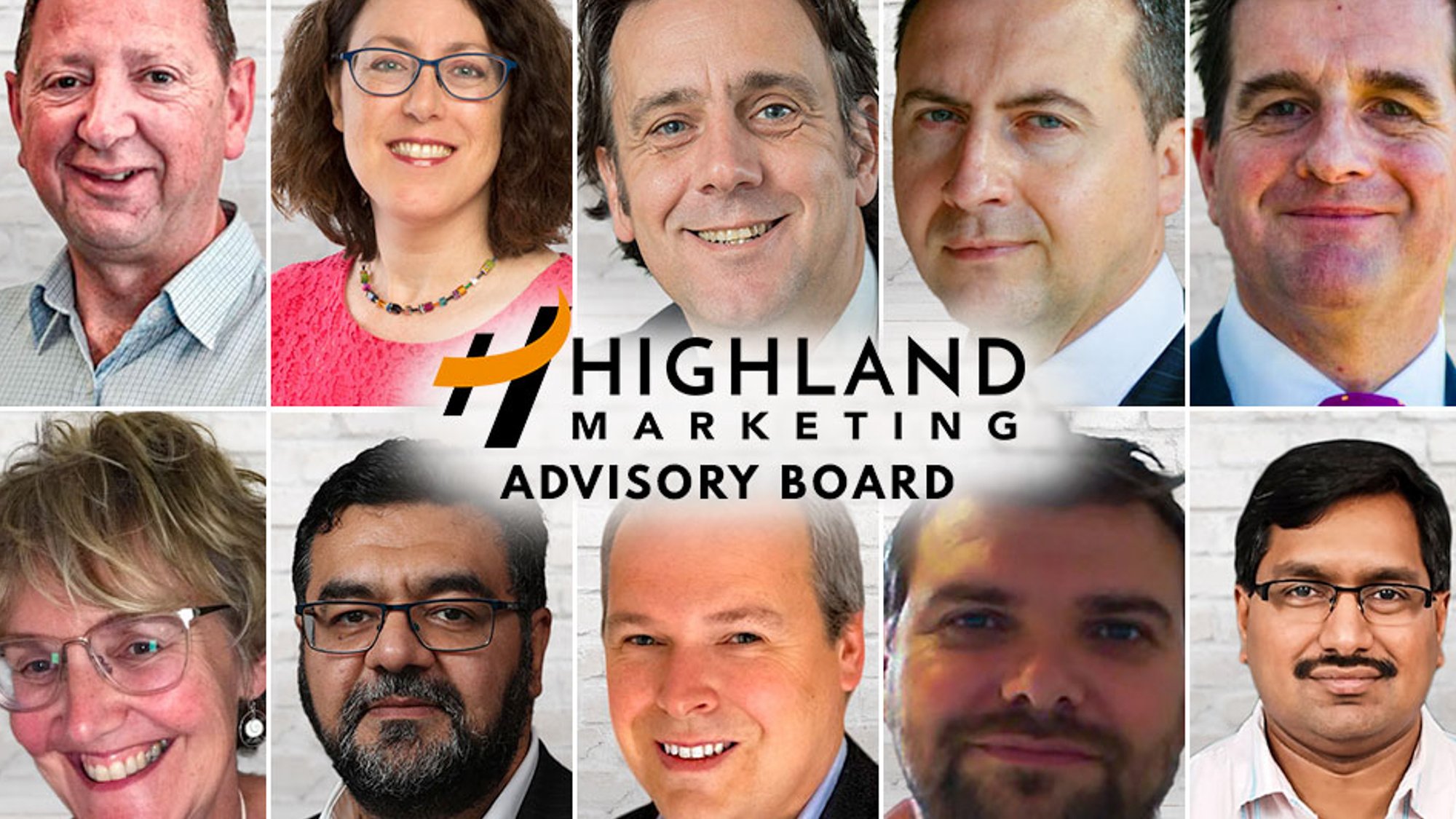
AUGUST - SEPTEMBER 2023
.jpg?width=2000&height=753&name=STEM%20Sustainability%20(2).jpg)

- STEM for Sustainability - Is STEM education ready for the challenges ahead?
- HealthTech Investing in 2023 - An investor's perspective on trends that have redefined the healthtech investment landscape.

- EdTechX Summit Opening Keynote - Envisioning a future beyond conventional AI.
- Clinical Trial Protocol Design - Leveraging the capabilities of Large Language Models.

A global snapshot of the EdTech, HealthTech & Impact Investing markets.

Notable M&A & Fundraising activities across EdTech & HealthTech industries
Global trends and innovation across the tech-led impact ecosystem.
In this issue:
Education Industry Analysis – The Green Skills Market
Healthcare Industry Analysis - Telehealth

Navigating Tomorrow: Is STEM Education Ready for the Challenges Ahead?
By Cemil Cihan Ozalevli, Co-Founder & Chief Content Officer at Twin Science
Sustainability has moved beyond a trendy term to a critical global necessity. Education plays a pivotal role in shaping a sustainable future in the midst of global challenges. By merging STEM+A education and 21st century technologies such as robotics, coding and AI, we can not only equip students with future skills but also drive progress towards sustainability.
Why Integrate Sustainability into STEM Education?
STEM education nurtures a deep comprehension of the world while blending different topics such as science, technology, engineering, art and math. It is a powerful catalyst for critical thinking and problem-solving. But the missing piece to fully understanding the world lies in sustainability. The true potential of STEM education is revealed when it is intertwined with environmental education, creating an educational approach that transforms students into global thinkers capable of solving environmental challenges.
By incorporating sustainability into STEM, students not only grasp scientific concepts but also learn to apply their knowledge to craft innovative solutions. This fosters a generation of holistic thinkers who understand the link between human actions, the planet's health and the regenerative ways to solve challenges.
‘’The truth is the 21st century is going to be a really challenging time for the rising generations. So it's imperative that we equip them with knowledge of the issues and the skills to deal with problems caused by climate change such as food security or water scarcity. We need to see STEM For Sustainability integrated into our curriculums just as thoroughly as English and maths are, and we need to see that in every school across the country.’’ -Marcus Culverwell, Headteacher at Reigate St Mary’s
Real-world projects and interdisciplinary exploration exemplify the fusion of STEM and sustainability. Students working together on sustainable energy solutions, for instance, grasp renewable energy intricacies and address global issues practically. This integration nurtures adaptable minds, fostering environmental stewardship. It enables students to analyze problems from various angles, envision innovative solutions, and work towards a more harmonious coexistence between humanity and nature.
AI-Powered Transformation: Education and Sustainability
Education, often regarded as the cornerstone of progress, is undergoing a profound revolution through the infusion of Generative AI tools. Powered by advanced algorithms, GenAI can now have the power to analyse individual student data and create personalized and adaptive learning experiences. This tailored approach caters to diverse learning styles and paces, improving comprehension and retention rates. The classroom is no longer a one-size-fits-all domain; AI ensures that each student's unique requirements are met.
The potential for a unique harmony between artificial intelligence, education, and sustainability presents an inspiring perspective for shaping a brighter and more sustainable future. Through its impact on education, artificial intelligence enables the maximization of individual learning potential. But it also has a huge potential for the teaching environment.
Educators will be the main drivers for this transformation, but they often face overwhelming responsibilities. Can technology, particularly AI, eliminate administrative tasks, freeing educators to have more time for in-depth personal connection with their students, personalizing their instruction methods and improving individual classroom engagement? Of course, it can! AI-empowered educators marry technology with the human spirit to envision a future where they can inspire inquiry, innovation, and inspiration in students without being burdened by workload.
How Can We Empower Teachers Using Technology?
According to data from Working Lives of Teachers and Leaders 2022 Survey, teachers have a significantly low level of confidence in the areas of computing, design & technology. (Figure 9.2) That's why at Twin Science, we integrate artificial intelligence into our educational tools to automate administrative tasks, streamline lesson planning, ease the student assignment and assessment, and personalize the student learning journey.
This empowerment enables teachers to engage with more students, stimulate critical thinking, and offer personalized guidance. This methodology not only fosters a more efficient and enriching educational environment, but also assists teachers in areas where they may lack confidence by reducing their workload.
Furthermore, GenAI can be employed to track students' unique preferences and interests, which can then be used to provide teachers with valuable insights. Understanding a student's area of interest becomes a powerful communication channel, fostering confidence and creating opportunities for perspective-taking between students and teachers.
Children Are the Proof of STEM for Sustainability
The fusion of STEM education, AI innovations, and efforts to support teachers propels us toward a more sustainable future. As students engage in hands-on projects, armed with AI-powered insights, they become architects of change. For example, with Twin's vision of STEM for Sustainability education, children now have the knowledge that natural disasters can be prevented and lives can be saved with an “Earthquake Detection” project. They see the impact of unsustainable farming and prototype “A Sustainable Farm” project, consider the accessibility of blind people and prototype a “Smart Cane” project, grasp the importance of saving the planet and prototype an “Ocean Cleaning Robot” using robotics and coding.
Thus, the future decision-makers, scientists, economists, engineers, and architects will prioritize the ecosystem, the lives of the residents and animals in the area, and their impact on the world. They will prioritize living “together” with the land, not “of” the land. They will be the changemakers and future leaders who will make a cultural transformation.
Empowered with innovative tools and ongoing professional development, teachers guide students on this transformative journey. By embracing these multifaceted approaches, we can collectively address environmental challenges and create a world that thrives sustainably.
In the face of mounting ecological concerns, the relationship between STEM education, AI innovations, and teacher support stands as a beacon of hope. By nurturing these interconnected pillars, we take significant strides toward empowering sustainability and forging a brighter future for future generations.
____________
Twin Science & Robotics is an award-winning UK company that develops children's STEM skills for a sustainable future.
By Joe Stringer, Investor-in-residence at L1 Impact
The pace of change in the healthcare sector, historically perceived as resistant to change and only really driven by rigorous research and clinical efficacy, has experienced seismic shifts in recent years thanks to the pace of improvements in technology, and benefitted from far more capital that is prepared to take a risk in a notoriously difficult sector to navigate. But over the past decade, the relationship between health and technology has been totally transformed, giving rise to trends that have redefined and reshaped the investment landscape. This is a quick look into what I am seeing today, reflecting on some healthcare ghosts from the past, present and future:
- Ghosts from The Past: A wave of consolidation?
The initial wave of healthtech adoption over the last five years has seen the rise of numerous startups eager to disrupt traditional models. Telehealth platforms like Babylon Health heralded the promise of democratised access to quality healthcare anywhere in the world, so their recent demise following a US listing is disheartening for the whole sector, but should not be taken out of context. There are many lessons to learn from this experience, not least (1) avoiding the temptation to paint the ‘new’ solution as something separate, better and working in competition with existing healthcare providers and clinicians, (2) over indexing on a digital-only offering (more on this later), and (3) being tempted to list prematurely on a public market (US or UK) that very rarely understands the unique dynamics of the healthcare sector. Similarly, we are seeing similar cracks appearing in other subsectors that went through a similar honeymoon period – for example the digital-only players promising to disrupt the clinical trials value chain are showing some cracks and struggling to grow into inflated 2021 valuations, and one where I think we can expect to see the same consolidation we are seeing in telehealth as it becomes increasingly commoditised. As an investor, seeing this consolidation of early players raises an essential question: is there ever a good case to back the early adopters, or do I wait for the initial hype to fade?
- The Present: The unstoppable rise of AI and the Embrace of Hybrid Solutions
Looking towards the final quarter of 2023, after what has been one of the most challenging fundraising years many healthtech founders have experienced, there are two unmistakeable patterns that are not just emerging but hitting us square between the eyes:
(a) No article on technology investing in 2023 would be complete without mention of AI, and for good reason – after decades of pretty unintelligent, gimmicky solutions playing at the edges of the sector, we are finally seeing the birth of quite revolutionary businesses sitting on top of vast LLMs (large language models), but with crazy valuations to match. Recently, one such (anonymous) opportunity secured seed stage valuations reminiscent of the 2021 tech boom rather than the 2023 slump, I hope for all concerned they are able to grow at the pace expected around the impressive cap table.
(b) The year that true service and hybrid models came of age: Many people forget that healthcare is ultimately a service industry, with 80% of its costs in people. From my perspective, the healthtech businesses that go with this flow and embrace high quality, high touch service rather than rail against it will be the ultimate winners. Companies like Patient21, Tympa Health, and Lightship demonstrate that a blend of technology and human touch can create the level of customer retention, loyalty and repeatable revenue curves that the likes of Babylon could never achieve with their purist obsession with SaaS-only delivery, and point towards a broader trend that hybrid delivery is finally coming of age. The NHS is set to become one of the world’s leading exemplars in hybrid delivery with its embrace of remote patient monitoring. It is just a shame it has taken an unprecedented crisis around the very 20th century problem of waiting lists to generate this kind of enthusiasm.
- The Future: Policy-Driven Growth and Technological Frontiers
The trajectory of healthtech investing in the UK is set to experience some seismic shifts in 2024. These are some of the things I am most excited by:
(a) Policy Shifts: The growth opportunity in health & life sciences hasn't gone unnoticed by policymakers. With the imminent pension fund reforms referred to in the Chancellors 2023 Mansion House speech, 2024 may witness an unprecedented influx of capital in growth-stage investing in the sector. This could be a game-changer, allowing UK healthtech businesses to delay their expansion to the US until they are sufficiently equipped with the kind of war chest they really need for global growth.
(b) Brain and Mental Health: Companies like musichealth.ai and Mettle are ushering in innovations that target brain health and hard-to-reach demographics. Mental health, a once-neglected facet of healthcare, is finally gaining the attention it deserves.
(c) Physical Automation is coming of age: After decades of underinvestment, grappling with levels of performance, error rates, inefficiency and injuries caused by RSI, the physical supply chains in life sciences and healthcare are finally on the brink of revolution, led by companies like Automata.tech bringing in robotic technology and software we are so used to seeing in most other manufacturing industries.
(d) The Promise of Digital Therapeutics (DTx): Recognised for their immense potential, digital therapeutics are now being combined with physical therapeutics and diagnostics. The likes of Closed Loop medicine exemplify this combination, and regulators are finally catching up, hinting at a much more joined up approach to therapeutic delivery.
On reflection, 2023 has been a year to challenge the hardiest of optimists, but the evolution of healthtech investing in the UK paints a picture of a sector that has learned some hugely valuable lessons and a offers huge opportunity for 2024.
____________
Joe Stringer is Investor-in-residence at L1 Impact, backing European growth stage healthtech businesses, NED at Holland & Barrett and a board advisor to many UK based startups.

Beyond AI: Key Insights from the EdTechX Summit Opening Keynote
The EdTechX 10th Anniversary Summit opened with the customary keynote address by founders Charles McIntyre and Benjamin Vedrenne-Cloquet, who this year reflected on the trajectory of the EdTech sector over the past decade and the humble beginnings of EdTechX before setting the stage for a thought-provoking expedition into the transformative potential of both Artificial Intelligence (AI) and the emerging concept of Organoid Intelligence (OI).
Reflecting on the Past Decade: Benjamin initiated the keynote by acknowledging the challenges that have confronted the EdTech industry, posing fundamental questions that encouraged attendees to critically assess the sector's achievements. With candour, he admitted to recent setbacks in EdTech and underscored the need for adaptation.
AI in Education: Charles then took the stage to explore AI's vast potential in education. He drew historical parallels between the fears surrounding past innovations and today's apprehensions about AI. Acknowledging the ethical concerns and biases associated with AI, Charles highlighted the noteworthy advancements in generative AI and Large Language Models like ChatGPT. He emphasized the importance of a cooperative relationship between humans and AI, suggesting that educators view AI as a tool for re-evaluating teaching methods and assessment practices.
A Glimpse of the Future with OI: In an unexpected shift, Benjamin directed the conversation toward the future of intelligence itself, offering a futuristic vision of a world where organoid intelligence (OI) surpasses conventional AI. He unveiled a groundbreaking paradigm shift in the understanding of intelligence, powered by lab-grown human brain cells and poised to redefine the boundaries of human cognition.
A Call to Action: As the keynote address concluded, the EdTechX founders encouraged the EdTech community to embark on a transformative journey of reinvention, underscoring the importance of adaptability in the face of change. Their message extended beyond EdTech to encompass a broader perspective on intelligence and knowledge. With an air of anticipation, they invited all stakeholders to embrace the transition from AI to OI, recognizing it as a path toward increased productivity and expanded creative possibilities.
Watch the EdTechX 2023 Opening Keynote on YouTube.
Using Generative AI for Clinical Trial Protocol Design
By Ece Kavalci, Machine Learning Engineer at Lindus Health
All new therapies need to undergo clinical trials to show they’re safe and effective. A protocol is a document that describes how a clinical study will be conducted, such as its design, objectives, and methodology. Traditionally, developing a study protocol requires an immense investment of time and effort, often requiring the retrieval and analysis of context and historical data. The initial draft is especially crucial, as it serves as the blueprint for the protocol and related documents. And despite the best intentions, there can be contradictions or even seemingly sensible additions that hamstring a trial—for example, adding so many exclusion criteria that a study is almost impossible to recruit patients for.
SPROUT* is an internal protocol generation tool currently at the proof-of-concept stage designed to speed up and enhance the effectiveness of developing study protocols by leveraging the capabilities of Large Language Models (LLMs). The tool radically reduces the time needed to generate the first draft using a small number of inputs, adhering to strict clinical standards. With user-provided data such as medical condition, method of intervention (e.g. drug, medical device), keywords and the study phase, SPROUT retrieves information from a filtered set of historical study protocols to use as context when generating each section of the document. This capability combines advanced information retrieval and state-of-the-art text generation using LLMs.
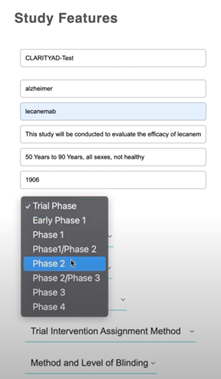 Additionally, SPROUT provides users with the flexibility to customise their documents using LLMs. Users can easily add, drop, or update each section in the generated draft according to their specific needs. This kind of user-directed customisation ensures that the document remains aligned with each clinical study's unique goals and constraints, making it a truly dynamic tool adaptable to a wide range of research settings.
Additionally, SPROUT provides users with the flexibility to customise their documents using LLMs. Users can easily add, drop, or update each section in the generated draft according to their specific needs. This kind of user-directed customisation ensures that the document remains aligned with each clinical study's unique goals and constraints, making it a truly dynamic tool adaptable to a wide range of research settings.
The tool’s capabilities extend beyond mere document generation. One of its standout features is its ability to query a comprehensive knowledge base from the clinicaltrials.gov database (an official registry of clinical trials). Users can easily search for answers to specific questions, lending a depth of context and historical perspective that is invaluable for designing a robust study protocol. The Q&A functionality also highlights specific published protocols that the LLM has used as context for answering a user’s queries. This empowers clinical researchers to understand the basis of the generated content, fostering a transparent and informed decision-making process.
____________
Lindus Health is a next-generation Clinical Research Organisation (CRO) running end-to-end trials for healthtech and life science pioneers. We have helped over 80 sponsors run entire clinical studies in Europe and the US up to 3x faster than traditional CROs. If you’re planning for your next clinical study, we’d love to hear from you.
*SPROUT - Study Protocol Resource, Outline, & Utility Toolkit

Estonia is quickly becoming a European EdTech powerhouse – so much so, EdTech Estonia was formed. The PIE News Read more
Faculty often feel they’re always on the job because of technology and the stress can stem from not feeling totally in control.
Times Higher Education Read more
Artificial intelligence is on track to shake up work. So what should the next generation of workers be trying to pursue?
The Guardian Read more
Numerous healthcare organizations are having to undergo significant restructuring processes to optimize their processes, or worse, completely shutter their operations.
Forbes Read more
The World Bank Read more
Revenue growth is good. Profitable growth is better. Profitable growth that advances ESG priorities is best. Here’s how outperformers who actively choose growth deliver the growth trifecta. McKinsey & Company Read more
For venture investors, the big lesson of 2023 is that valuations set in an upbeat funding environment can quickly come down. Crunchbase News Read more
A healthcare investment specialist unpacks the investment considerations when it comes to healthcare ETFs.
Nasdaq Read more

Education

Health

Education

Health

Sources:
1Capital IQ, HealthTech Alpha
2Deal announced but not yet closed

The global workforce is witnessing a notable increase in individuals seeking green skills – defined as those that enable the environmental sustainability of economic activities. The proportion of individuals with green skills has increased significantly, growing from 9.6% in 2015 to 13.3% in 2021, representing a 38.5% increase4. Growth is expected to persist as the global job market evolves in the coming decade, largely driven by the implementation of new climate policies and commitments. For instance, in the US, the number of jobs in the Renewables and Environment sector has surged by 237.0% in the past five years, compared to the 19.0% increase in jobs in the Oil and Gas sector. However, despite the numerous job opportunities in the green sector, the demand for individuals with green talent and skills is surpassing the available supply. To effectively bridge this gap, it is imperative for both policymakers and business leaders to fully embrace this transformation and, at the same time, establish a clear understanding of the workforce's requirements and the critical skills necessary to meet the demands of the green economy4.
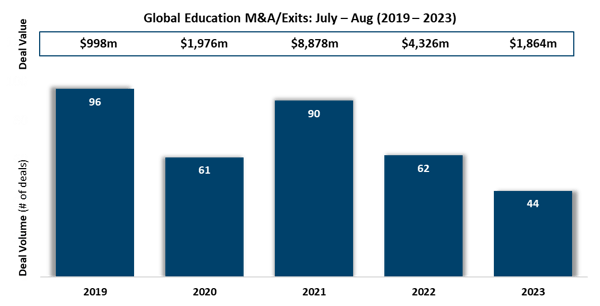
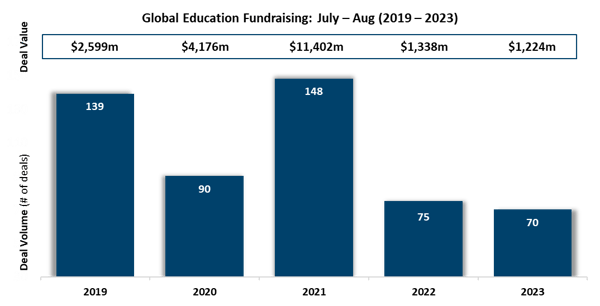
In contrast to the surge in demand for green skills, the global education industry, which supports the transition, has experienced an overall decline in funding and M&A activity. Although this decline is relatively modest when compared to the same period in 2022, the combined volumes of M&A and fundraising have seen a significant drop, marking respective decreases of 51% and 53% from 2021. In 2021, central bank support boosted market valuations, however, in 2022, rising inflation prompted interest rate hikes, causing market values to decline. These reduced valuations made investment in the industry less appealing, contributing to the decline across the sector 5. At present, M&A activities are primarily concentrated in North America, while fundraising efforts exhibit a more balanced distribution across North America, APAC, and Europe 1.
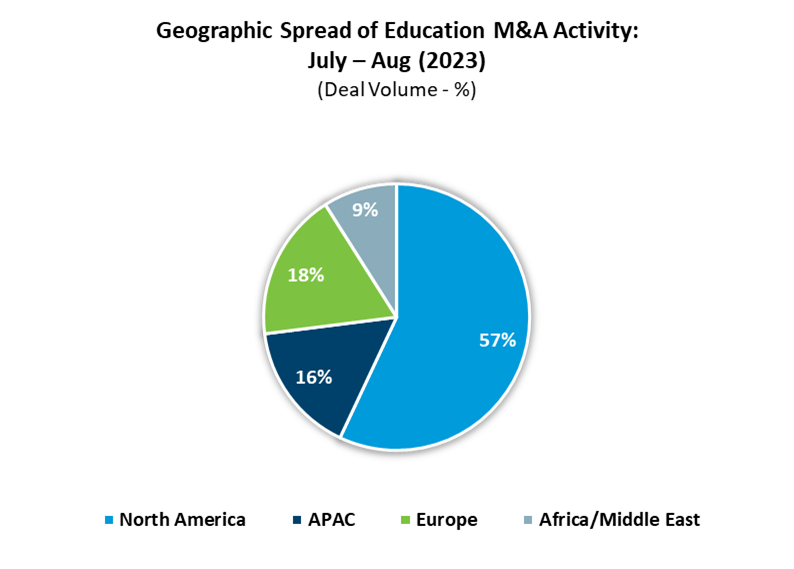

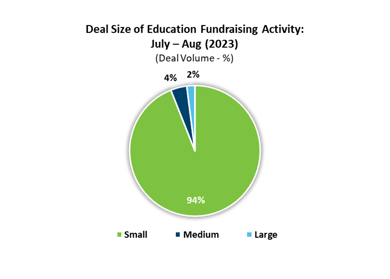
Despite the slowdown in fundraising and M&A activity, the EdTech landscape has continued to shift towards increasing their sustainability offering. Recognising the urgent global need to confront environmental challenges and transition towards a more sustainable future, EdTech companies have begun actively developing products and partnering with education providers to equip individuals with the necessary skills to succeed in the green economy. These include incorporating green education into their offerings with the notable inclusion of STEM (Science, Technology, Engineering, and Mathematics) education tailored to sustainability within this evolving landscape.
This trend in STEM for sustainability can be seen at EdTech companies such as Coursera, edx, LinkedIn Learning, FutureLearn and Udemy, all of which offer a wide array of courses within the STEM field, specifically tailored to green skills and environmental sustainability. The courses offered cover a broad spectrum of topics, such as environmental science, sustainable energy systems, sustainable architecture, renewable energy, and environmental conservation, among others. In conclusion, the intersection of EdTech and sustainability is a promising frontier, with a strong emphasis on STEM education as the foundation for a greener future. EdTech companies are not just facilitating learning but also cultivating a workforce capable of addressing the most pressing global challenges. As we move forward, the impact of EdTech on STEM for sustainability is poised to be transformative.
Notes
1. Capital IQ
2. Includes deals announced but not yet closed
3. Relates only to deals with disclosed transaction amounts. Small deals are considered to be <$50m; Medium deals are considered to be ≥$50m and <$150m; Large deals are considered to be ≥$150m
4. LinkedIn Economic Graph
5. McKinsey
Following the COVID-19 pandemic, there has been a notable transformation in healthcare delivery. This shift includes the widespread adoption of at-home testing and the utilisation of remote health monitoring devices, extending to cover a wide variety of medical indicators. Furthermore, due to limitations on in-person healthcare visits, telecommunication technologies have emerged as accessible alternatives for consulting with healthcare professionals3.

These shifting trends were seen globally, with notable cases appearing in both the US and the UK. In the US, approximately 40% of providers now offer telemedicine services, a significant increase from the pre-pandemic level of 15%4. Similarly, the UK experienced a substantial transition to virtual GP appointments during the pandemic. While many of these appointments have returned to in-person visits, strategic plans are underway to expand the utilisation of telemedicine-classed appointments. These measures aim to alleviate current hospital capacity pressures, with in-person outpatient appointments predicted to reduce by a third by 20245.
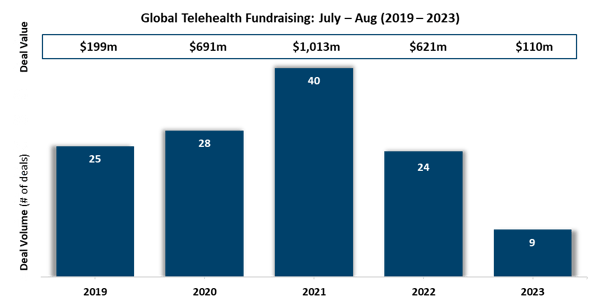
Despite the positive global Telehealth developments caused by the pandemic, there have been some notable signs of stress within the industry. Babylon, a Telehealth service provider operating in both the US and UK, underwent a delisting from the NYSE in June 2023 due to disappointing financial performance and a declining share price. Subsequently, in August 2023, the company filed for bankruptcy in the US6. Similarly, mobile health provider, Pear Therapeutics, filed for bankruptcy due to a funding gap caused by insurers refusing to pay for its therapies 7. These collapses occurred despite Babylon and Pear Therapeutics collectively securing funding of $1.2bn and $409.0m, respectively 8.
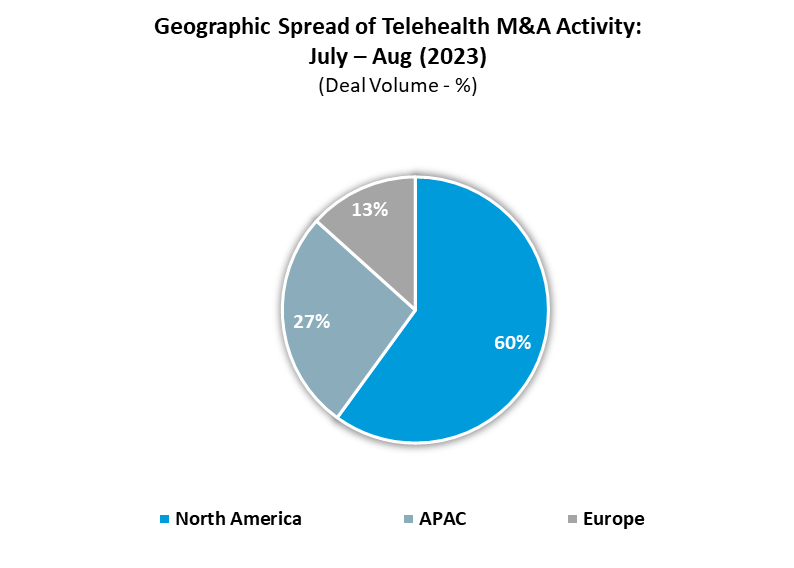
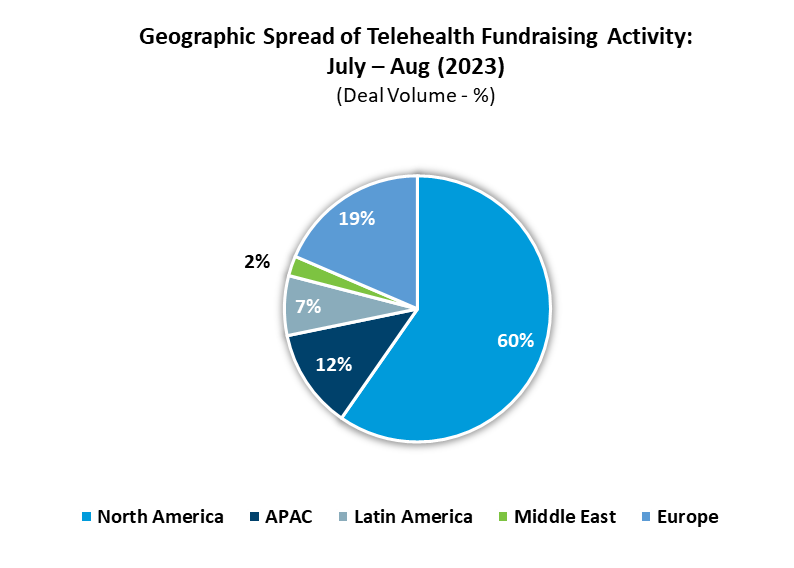
In addition to these signs of tapering performance, the decline in Telehealth exuberance can also be seen in the industry funding environment. In July and August of 2023, 9 companies raised a collective $110.4m, which contrasts with the same period in 2021 where over $1.0bn was secured across 40 separate funding rounds. The amount of funding has been notably constrained across all 9 rounds, with none exceeding $50m in size. Notably, North America dominated the funding landscape, having accounted for 60% of all funding rounds by volume, followed by Europe (19%) and APAC (12%) 1.
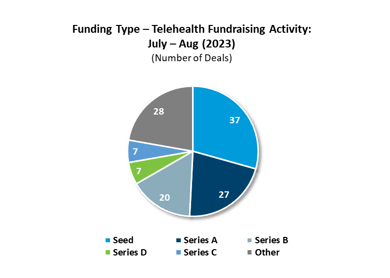
Despite the recent industry setbacks, Telehealth is expected to continue its overall success, driven by cost savings, increased access to healthcare, ageing populations, a growing disease burden and the loosening of telemedicine regulations globally 4. This loosening in regulations can be seen in recent legislative and regulatory changes. Most notably, the US Drug Enforcement Administration (DEA) proposed permanent rules for prescribing controlled medications via telemedicine, signalling a commitment to its long-term integration into healthcare9.
Notes
1. HealthTech Alpha
2. Includes deals announced but not yet closed
3. Medical Device Network
4. Globaldata
5. Nuffield Trust
6. TechCrunch
7. Forbes
8. Crunchbase
9. DEA





